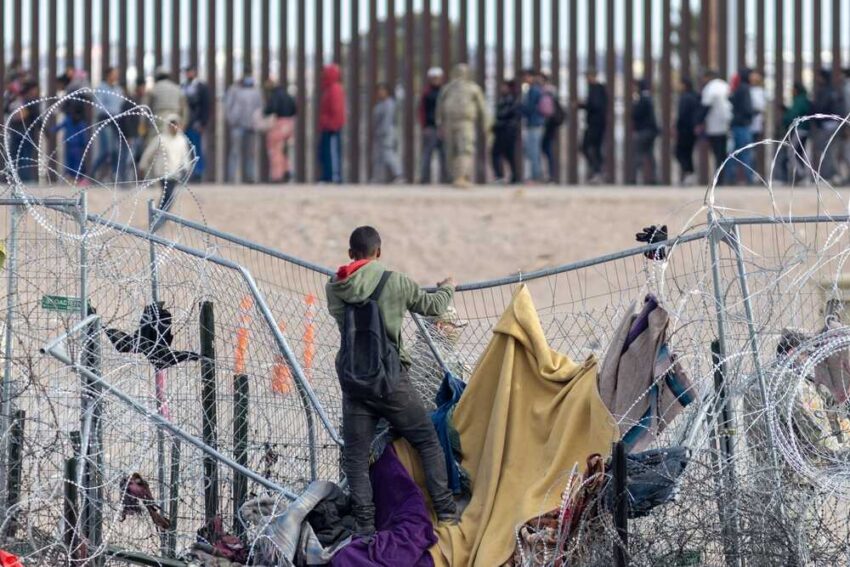(LibertySociety.com) – Three migrants stranded atop the towering 30-foot border fence in Otay Mesa were dramatically rescued by emergency responders, highlighting the increasingly desperate and dangerous methods being employed to cross America’s southern border.
Key Takeaways
- Three individuals required emergency rescue after becoming stranded on the U.S.-Mexico border fence in Otay Mesa
- CBP is constructing 2.5 miles of new 30-foot steel bollard barriers with anti-climb features in San Diego County
- Authorities discovered a sophisticated half-mile tunnel connecting Tijuana to San Diego, equipped with electrical wiring, ventilation, and rail systems
- Border crossing attempts continue despite enhanced security measures, putting migrants at serious risk of injury or death
- The administration continues infrastructure projects at the border while facing criticism for insufficient enforcement policies
Dangerous Border Crossing Attempts Continue
Emergency responders were called to the U.S.-Mexico border fence in Otay Mesa to rescue three individuals who had become stranded atop the imposing barrier structure. The rescue required specialized equipment to safely remove the migrants from their precarious position. This incident represents just one of many dangerous crossing attempts that continue to occur along our southern border, where migrants risk their lives climbing barriers, traversing harsh terrain, or navigating underground tunnels in attempts to enter the country illegally.
While the Biden-Harris administration has faced intense criticism for policies that many argue have encouraged mass illegal immigration, U.S. Customs and Border Protection (CBP) continues to construct new physical barriers in high-traffic areas. In San Diego County, CBP is building 2.5 miles of new border barriers, including 2.1 miles near Jacumba Hot Springs and 0.4 miles west of the Otay Mesa Port of Entry. These barriers consist of 30-foot steel bollards with anti-climb features and drainage gates, designed to deter the very type of crossing attempt that led to this recent rescue.
Sophisticated Tunnel Network Discovered
In a significant border security development, authorities uncovered an elaborate half-mile-long tunnel connecting Tijuana, Mexico, to a warehouse in San Diego. The tunnel, measuring 42 inches in height and 28 inches in width, was equipped with electrical wiring, ventilation systems, and even rail infrastructure. After months of surveillance, officials finally shut down this sophisticated smuggling route in June 2025, demonstrating the lengths to which cartels and smugglers will go to circumvent border security measures.
“This discovery represents one of the most sophisticated cross-border tunnels we’ve encountered,” said a senior Border Patrol official involved in the operation. “These underground passages pose serious national security concerns and highlight the ongoing challenges we face in securing our southern border.”
The discovery of this tunnel underscores the persistent threat posed by transnational criminal organizations that continue to adapt their smuggling methods in response to enhanced border security. While the administration has invested in technology and infrastructure at ports of entry, critics argue that these efforts are undermined by policies that process and release many illegal entrants into the country, creating incentives for more to attempt the dangerous journey.
Ongoing Border Infrastructure Projects
Despite campaign promises to halt border wall construction, the administration has continued several border infrastructure projects. The Otay Mesa Port of Entry, California’s busiest commercial crossing, is undergoing significant modernization with upgraded pedestrian pathways and enhanced biometric systems. These improvements aim to facilitate legal crossings while strengthening security measures against illicit activities. However, these efforts do little to address the hundreds of miles of border where illegal crossings continue unabated.
CBP’s public comment period for the new barriers closed in May 2025, with the agency citing both environmental and socioeconomic impacts in its assessment. Critics point out that while the administration reluctantly continues some Trump-era border security projects, it has simultaneously implemented policies that many believe have fueled the ongoing border crisis, including the termination of the “Remain in Mexico” policy and restrictions on ICE enforcement actions.
Physical Dangers and Human Cost
The physical dangers associated with illegal border crossings remain severe. Climbing the 30-foot border barriers poses life-threatening risks, including falls that can result in serious injuries or death. Similarly, navigating underground tunnels exposes migrants to dangers such as entrapment, structural collapse, and poor air quality. The recent rescue operation in Otay Mesa highlights these risks, as the individuals required emergency assistance after becoming stranded in a precarious position atop the barrier.
“These barriers aren’t just about enforcement—they’re about saving lives,” explained a veteran Border Patrol agent. “When we implement strong border security measures, we actually reduce the number of people putting themselves in life-threatening situations. The humanitarian crisis at our border demands both compassion and firm enforcement of our laws.”
While the administration continues to face criticism for its handling of the border crisis, the ongoing construction of physical barriers and the enforcement actions against smuggling operations demonstrate that even this administration recognizes the necessity of some border security measures. However, without a comprehensive approach that includes consistent enforcement of immigration laws and cooperation with Mexico and Central American countries, dangerous crossing attempts and the associated human suffering will likely continue.
Copyright 2025, LibertySociety.com
Click this link for the original source of this article.
Author: Editor
This content is courtesy of, and owned and copyrighted by, https://libertysociety.com and its author. This content is made available by use of the public RSS feed offered by the host site and is used for educational purposes only. If you are the author or represent the host site and would like this content removed now and in the future, please contact USSANews.com using the email address in the Contact page found in the website menu.








